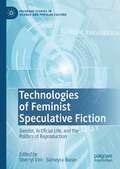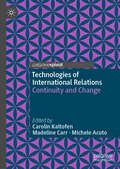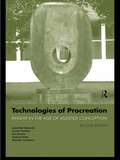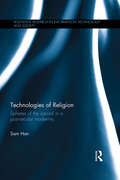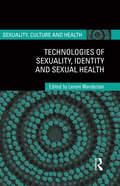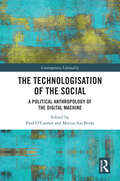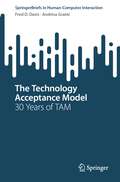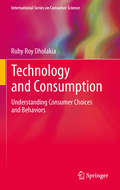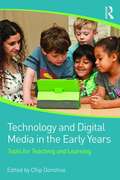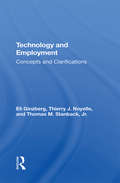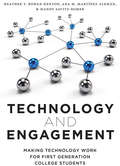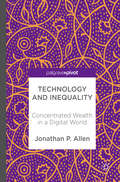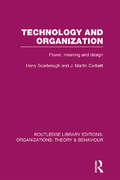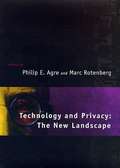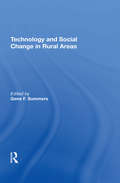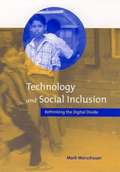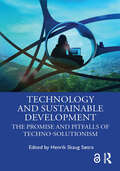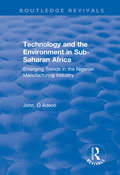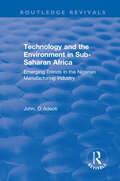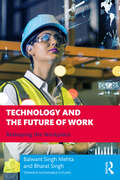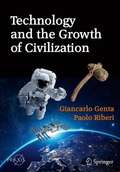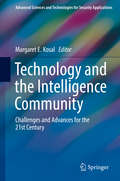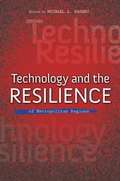- Table View
- List View
Technologies of Feminist Speculative Fiction: Gender, Artificial Life, and the Politics of Reproduction (Palgrave Studies in Science and Popular Culture)
by Sherryl Vint Sümeyra BuranTechnologies of Feminist Speculative Fiction: Gender, Artificial Life, and the Politics of Reproduction explores how much technology has reshaped feminist conversations in the decades since Donna Haraway’s influential “Cyborg Manifesto” was published. With sections exploring reproductive technologies, new ways of imagining femininity and motherhood via artificial means, queer readings of gender as a social technology, and posthuman visions of a world beyond gender, this book demonstrates how feminist speculative fiction offers an urgently needed response to the intersections of women’s bodies and technology. This collection brings together authors from Europe, Japan, the US and the UK to consider speculative films and texts, reproductive technologies and food futures, and opportunities to rethink family, aging, gender and sexuality, and community through feminist speculative fiction, a social technology for building better futures.
Technologies of International Relations: Continuity And Change
by Carolin Kaltofen Madeline Carr Michele AcutoThis book examines the role of technology in the core voices for International Relations theory and how this has shaped the contemporary thinking of ‘IR’ across some of the discipline’s major texts. Through an interview format between different generations of IR scholars, the conversations of the book analyse the relationship between technology and concepts like power, security and global order. They explore to what extent ideas about the role and implications of technology help to understand the way IR has been framed and world politics are conceived of today. This innovative text will appeal to scholars in Politics and International Relations as well as STS, Human Geography and Anthropology.
Technologies of Procreation: Kinship in the Age of Assisted Conception
by Jeanette Edwards Sarah Franklin Eric Hirsch Frances Price Marilyn StrathernTechnologies of Procreation bridges the gap between medical technology and cultural values. It looks at the ways in which the 'technologies of procreation' affect society from an anthropological perspective.
Technologies of Religion: Spheres of the Sacred in a Post-secular Modernity (Routledge Research in Information Technology and Society)
by Sam HanBringing together empirical cultural and media studies of religion and critical social theory, Technologies of Religion: Spheres of the sacred in a post-secular modernity investigates powerful entanglement of religion and new media technologies taking place today, taking stock of the repercussions of digital technology and culture on various aspects of religious life and contemporary culture more broadly. Making the argument that religion and new media technologies come together to create "spheres"—environments produced by an architecture of digital technologies of all sorts, from projection screens to social networking sites, the book suggests that prior social scientific conceptions of religious worship, participation, community and membership are being recast. Using the case of the strain of American Christianity called "multi-site," an emergent and growing church-model that has begun to win favor largely among Protestants in the last decade, the book details and examines the way in which this new mode of religiosity bridges the realms of the technological and the physical. Lastly, the book situates and contextualizes these developments within the larger theoretical concerns regarding the place of religion in contemporary capitalism. Technologies of Religion: Spheres of the sacred in a post-secular modernity offers an important contribution to the study of religion, media, technology and culture in a post-secular world.
Technologies of Sexuality, Identity and Sexual Health (Sexuality, Culture and Health)
by Lenore MandersonTechnologies of Sexuality, Identity and Sexual Health highlights the complex ways in which sexuality is expressed and enacted through local ideologies, global identities and material cultures, and their influence on people’s sexual health and well-being. Its impetus is the renewed interest in technology and the ‘social life of things,’ including pharmaceuticals, expanded sexual and related surgery, the growing exploitation of markets for sexual and contraceptive products, and the impact of these on sexual and health practices and outcomes. Organised loosely into three parts, the opening chapters concentrate on female contraception, its availability, and the varied cultural significance attached to the ability to control its use, exploring the politics of reproductive health and birth control, and the ties between technology and power. The middle section turns its attention to men, and the impact of traditional and contemporary concerns about masculinity, and the social and sexual roles of men. The final chapters look at the commonalities across cultural borders and sexual gendered identities – how products and procedures travel, not only through the formal channels of globalisation, but also informally, carried by individuals across cultural and social boundaries through sexual, social and commercial interactions. The volume brings together anthropologists, sociologists and cultural studies scholars, both senior and emerging, from around the globe. Offering an important and topical contribution to the developing global literature on sexuality, sexual identity, culture and health, it is of interest to researchers and advanced students in these areas.
The Technologisation of the Social: A Political Anthropology of the Digital Machine (Contemporary Liminality)
by Paul O’Connor and Marius Ion BențaIn an era of digital revolution, artificial intelligence, big data and augmented reality, technology has shifted from being a tool of communication to a primary medium of experience and sociality. Some of the most basic human capacities are increasingly being outsourced to machines and we increasingly experience and interpret the world through digital interfaces, with machines becoming ever more ‘social’ beings. Social interaction and human perception are being reshaped in unprecedented ways. This book explores this technologisation of the social and the attendant penetration of permanent liminality into those aspects of the lifeworld where individuals had previously sought some kind of stability and meaning. Through a historical and anthropological examination of this phenomenon, it problematises the underlying logic of limitless technological expansion and our increasing inability to imagine either ourselves or our world in other than technological terms. Drawing on a variety of concepts from political anthropology, including liminality, the trickster, imitation, schismogenesis, participation, and the void, it interrogates the contemporary technological revolution in a manner that will be of interest to sociologists, social and anthropological theorists and scholars of science and technology studies with interests in the digital transformation of social life.
The Technology Acceptance Model: 30 Years of TAM (Human–Computer Interaction Series)
by Fred D. Davis Andrina GranićThis SpringerBrief discusses the origins, emergence, evolution, and future of the Technology Acceptance Model (TAM). TAM, simple yet powerful, has been extensively validated, standing as a leading scientific paradigm and a reliable model for explaining, predicting, and improving user acceptance across a spectrum of technological deployments. Over more than three decades since the introduction of TAM, numerous extensions have emerged, incorporating additional variables and collectively referred to as “TAM++”. However, perceived usefulness and perceived ease of use remain the basic beliefs of the core TAM model. The introductory chapter “Once upon a TAM” focuses on the challenging search for a user acceptance crystal ball, showing that it is indeed possible to consistently predict, explain, and improve user acceptance. “Evolution of TAM” traces the model's growth and adaptability, exploring the proliferation of selected TAM-related behavioural intention models, several integrated theoretical approaches, the quest for other behavioural intention antecedents, and TAM’s versatile applications in various contexts. “Revolution of TAM” presents an in-depth systematic review, encompassing a meta-analysis of selected TAM reviews and meta-analyses, and a narrative review of representative primary studies, providing a thorough and extensive understanding of the TAM universe. The epilogue “What will the Future of TAM be Like?” provides insights into its dynamic future. This SpringerBrief concludes with seven actionable principles, serving as a strategic guide for those aiming to customize the TAM++ body of knowledge for application-oriented studies within a particular context. This comprehensive overview of TAM is a valuable source of information for researchers, practitioners, and all interested readers, especially those new to the field.
Technology and Consumption
by Ruby Roy DholakiaTechnology and Household Consumption is a comprehensive text that provides insights into technology's impact on consumer behavior and the household environment. Consumption and consumer behavior has become a very important subject of study that is now covered in many disciplines including family economics, culture studies, and feminist/women studies. In the first section, this book provides a historical perspective on how consumer behaviors have changed because of technology and how technology itself has changed. Data on ownership and expenditures is detailed in describing the penetration of technology in the household and changes over time. In the examination of demographics and social changes, an emphasis is placed on women and children. As it is important to understand the entry paths and factors that influence them, the book also introduces a research framework to understanding the adoption and utilization of household technologies. In the second section, the book examines specific household technologies and consumption experiences including shopping choices and behaviors, entertainment outlets and availability, communications technologies, and working at home. The book concludes with a section on the relationships between marketers and consumers.
Technology and Democracy: Toward A Critical Theory of Digital Technologies, Technopolitics, and Technocapitalism (Medienkulturen im digitalen Zeitalter)
by Douglas KellnerAs we enter a new millennium, it is clear that we are in the midst of one of the most dramatic technological revolutions in history that is changing everything from the ways that we work, communicate, participate in politics, and spend our leisure time. The technological revolution centers on computer, information, communication, and multimedia technologies, is often interpreted as the beginnings of a knowledge or information society, and therefore ascribes technologies a central role in every aspect of life. This Great Transformation poses tremendous challenges to critical social theorists, citizens, and educators to rethink their basic tenets, to deploy the media in creative and productive ways, and to restructure the workplace, social institutions, and schooling to respond constructively and progressively to the technological and social changes that we are now experiencing.
Technology and Digital Media in the Early Years: Tools for Teaching and Learning
by Chip DonohueThis book provides strategies, theoretical frameworks, links to research evidence, descriptions of best practice, and resources to develop essential digital literacy knowledge, skills, and experiences for early childhood educators in the digital age.
Technology and Disability: 50 Years of Trace R&D Center Contributions and Lessons Learned (Synthesis Lectures on Technology and Health)
by Gregg Vanderheiden Jonathan Lazar Amanda Lazar Hernisa Kacorri J. Bern JordanThis book outlines the development of the Trace R&D Center as an institution for furthering accessible and assistive technologies. The book walks readers through the Center’s nascent attempts to solve individual challenges with augmentative communication devices through contemporary efforts to establish global frameworks and infrastructures for accessibility. This book is premised on the Center’s mission to maximize the potential of people with disabilities by harnessing evolving technologies while at the same time dismantling the barriers created by those same technological advancements. Readers will learn how this has been done in the past and why this practice should be a fundamental and integrated feature in new technology planning and implementation. The book touches on pre-internet technologies before exploring the huge implications of, first, the personal computer and, second, the Internet. In parallel with the massive growth in scale rendered by the launch of the Web, the book traces the expansion of the Center’s focus from the individual to the universal, particularly in working to establish accessibility standards and infrastructures. Learning from the successes and failures of the Center, the book outlines many past challenges and future directions for the development of technologies for people with disabilities from the research and industry perspectives.
Technology And Employment: Concepts And Clarifications
by Eli Ginzberg Thierry J Noyelle Thomas M Stanback JrThis volume is the first of four publications that will present the research on technology and employment carried out by Conservation of Human Resources of Columbia University over the past several years. This research was started with a small grant from the Rockefeller Foundation in 1982.
Technology and Engagement: Making Technology Work for First Generation College Students
by Heather T. Rowan-Kenyon Ana M. Martínez Alemán Mandy Savitz-RomerTechnology and Engagement is based on a four-year study of how first generation college students use social media, aimed at improving their transition to and engagement with their university. Through web technology, including social media sites, students were better able to maintain close ties with family and friends from home, as well as engage more with social and academic programs at their university. This ‘ecology of transition’ was important in keeping the students focused on why they were in college, and helped them become more integrated into the university setting. By showing the gains in campus capital these first-generation college students obtained through social media, the authors offer concrete suggestions for how other universities and college-retention programs can utilize the findings to increase their own retention of first-generation college students.
Technology and Inequality
by Jonathan P. AllenThis book will summarize what we know about technology and inequality across disciplines, and seek out new ways to analyze this relationship based on technology and business practices, with the objective of restoring digital technology as an engine of opportunity. Besides the unique focus on the role of technology in inequality, the book will have a unifying theme of tracing wealth creation and wealth capture in the technology sector, and relating specific practices--what technology companies actually do--to larger shifts in wealth and power. A clear conceptual framework will be used to analyze key industry case studies: search engines, social media, and the 'sharing' economy.
Technology and Organization: Power, Meaning and Deisgn (Routledge Library Editions: Organizations)
by Harry Scarbrough J. Martin CorbettIn this important MBA text the authors adopt a highly integrated approach. Using the three conceptual lenses of power, meaning and design they explore fully the many different ways in which technology and organizations interact. They highlight the major debates within these competing perspectives and argue that the flow of knowledge and ideas within and between organizations is crucial in shaping technologies and organizations alike.
Technology and Privacy: The New Landscape
by Philip E. Agre Marc RotenbergPrivacy is the capacity to negotiate social relationships by controlling access to personal information. As laws, policies, and technological design increasingly structure people's relationships with social institutions, individual privacy faces new threats and new opportunities. Over the last several years, the realm of technology and privacy has been transformed, creating a landscape that is both dangerous and encouraging. Significant changes include large increases in communications bandwidths; the widespread adoption of computer networking and public-key cryptography; mathematical innovations that promise a vast family of protocols for protecting identity in complex transactions; new digital media that support a wide range of social relationships; a new generation of technologically sophisticated privacy activists; a massive body of practical experience in the development and application of data-protection laws; and the rapid globalization of manufacturing, culture, and policy making. The essays in this book provide a new conceptual framework for the analysis and debate of privacy policy and for the design and development of information systems. The authors are international experts in the technical, economic, and political aspects of privacy; the book's strength is its synthesis of the three. The book provides equally strong analyses of privacy issues in the United States, Canada, and Europe. Contributors: Philip E. Agre, Victoria Bellotti, Colin J. Bennett, Herbert Burkert, Simon G. Davies, David H. Flaherty, Robert Gellman, Viktor Mayer-Schouml;nberger, David J. Phillips, Rohan Samarajiva.
Technology And Social Change In Rural Areas: A Festschrift For Eugene A. Wilkening
by Gene F SummersThe possibility of nuclear war, the failure of the Green Revolution, the capabilities of genetic engineering, and other actual and potential effects of technological innovations have created demands for a more humane application of technology. Addressing this issue, Technology and Social Change in Rural Areas is a clear assessment of the current state of affairs. The book begins with a discussion of the changing paradigms of technology adoption and diffusion, the dynamics of public resistance, and the question of social responsibility in an age of synthetic biology. In subsequent sections, the contributors assess the revolutionary effect of technology on agriculture worldwide and conclude that radically new public policies are essential; expose the transformations of rural life and communities that result from the localized effects of technology and its use as a weapon in world-system politics; and critically examine the appropriate technology movement. The essays are presented to honor Professor Eugene A. Wilkening for his many pioneering and lasting contributions to the study of technology and rural social change. The book includes an intellectual biography of Professor Wilkening written by his long-time colleague and friend, William H. Sewell.
Technology and Social Inclusion: Rethinking the Digital Divide
by Mark WarschauerMuch of the discussion about new technologies and social equality has focused on the oversimplified notion of a "digital divide." Technology and Social Inclusion moves beyond the limited view of haves and have-nots to analyze the different forms of access to information and communication technologies. Drawing on theory from political science, economics, sociology, psychology, communications, education, and linguistics, the book examines the ways in which differing access to technology contributes to social and economic stratification or inclusion. The book takes a global perspective, presenting case studies from developed and developing countries, including Brazil, China, Egypt, India, and the United States. A central premise is that, in today's society, the ability to access, adapt, and create knowledge using information and communication technologies is critical to social inclusion. This focus on social inclusion shifts the discussion of the "digital divide" from gaps to be overcome by providing equipment to social development challenges to be addressed through the effective integration of technology into communities, institutions, and societies. What is most important is not so much the physical availability of computers and the Internet but rather people's ability to make use of those technologies to engage in meaningful social practices.
Technology and Sustainable Development: The Promise and Pitfalls of Techno-Solutionism
by Henrik Skaug SætraTechnological change is at the core of all major disruptions in human history, and revolutions, wars, and general development are regularly connected to some sort of technological change. However, not all development is beneficial. While technology has fueled great innovations and rapid development, the notion of sustainable development has gained prominence as we now experience serious social, economic, and environmental challenges. This book examines whether technology can be used to fix the very problems caused by technology, as the various chapters examine different aspects related to how technology has brought us where we are today (which some will say is the best place humanity’s been at according to a range of metrics), and whether technology helps or hinders us in our efforts to solve the challenges we currently face. The issues discussed cover the three sustainability dimensions and include topics such as the materiality of AI, technology in education, AI for gender equality, innovation and the digital divide, and how technology relates to power, the political system, and capitalism. The chapters all build on the theoretical backdrop of technological change, sustainable development, and the UN’s Sustainable Development Goals are actively used throughout this book, both to examine how these goals capture or overlook central elements of sustainable development, and also to facilitate and create a common framework of engagement between the chapters. This book provides a novel combination of traditional theories that are explored through different case studies, providing the ground for a better understanding of how and when technology can –and cannot –be the enabler of sustainable development. It is thus an important resource for students of all disciplines, technologists, and those developing and applying new technologies. It is also a valuable resource for politicians and regulators attempting to harness the power of technology for good, while limiting its negative potential. The Open Access version of this book, available at www.taylorfrancis.com, has been made available under a Creative Commons [Attribution-Non Commercial-No Derivatives (CC-BY-NC-ND)] 4.0 license. Funded by Ostfold University College.
Technology and the Environment in Sub-Saharan Africa: Emerging Trends in the Nigerian Manufacturing Industry (Routledge Revivals)
by John. O AdeotiThis title was first published in 2002. Why do firms adopt pollution control technologies? How can environmental policy be strengthened? How can technology and industrial policies achieve green innovation? This volume critically examines whether the "stimulus-response" notion of environmental policy functions as the primary motivation for the adoption of pollution control technologies. It also questions whether technology and industrial policies can help to achieve the objective of green innovation. Interesting and well-researched empirical case studies offer important insights into the observed trends in the quantitative analysis. Focusing in particular on Nigerian industry, John Adeoti exposes the gains from and constraints upon firms' technology investment in pollution control.
Technology and the Environment in Sub-Saharan Africa: Emerging Trends in the Nigerian Manufacturing Industry (Routledge Revivals)
by John. O AdeotiThis title was first published in 2002. Why do firms adopt pollution control technologies? How can environmental policy be strengthened? How can technology and industrial policies achieve green innovation? This volume critically examines whether the "stimulus-response" notion of environmental policy functions as the primary motivation for the adoption of pollution control technologies. It also questions whether technology and industrial policies can help to achieve the objective of green innovation. Interesting and well-researched empirical case studies offer important insights into the observed trends in the quantitative analysis. Focusing in particular on Nigerian industry, John Adeoti exposes the gains from and constraints upon firms' technology investment in pollution control.
Technology and the Future of Work: Reshaping the Workplace (Towards Sustainable Futures)
by Balwant Singh Mehta Bharat SinghThis book examines how the progress of digital technology is transforming the world of work, skill demand, labour market institutions, and regulations in countries like India. It studies the challenges, opportunities, and current and future contributions of digital technologies. The volume poses salient questions regarding the ICT sector, I4.0 technologies, the gig economy, remote work, and the regulatory environment, and interrogates the policy and regulatory measures needed to promote more inclusive and decent work in the future.Part of the Towards Sustainable Futures series, this book will be an essential read for scholars and researchers of economics, sustainable development, sociology of work, labour economics, Indian economy, public policy, and human resource management. It will also be extremely useful to policymakers, government organisations, civil society organisations, and those in the corporate sector.
Technology and the Growth of Civilization (Springer Praxis Books)
by Giancarlo Genta Paolo RiberiOur natural world has been irretrievably altered by humans, for humans. From domesticated wheat fields to nuclear power plants and spacecraft, everything we see and interact with has in some way been changed by the presence of our species, starting from the Neolithic era so many centuries ago. This book provides a crash course on the issues and debates surrounding technology’s shifting place in our society. It covers the history of our increasingly black-box world, which some theorize will end with technology accelerating beyond our understanding. At the same time, it analyzes competing trends and theories, the lack of scientific knowledge of large sections of the population, the dogmas of pseudoscience, and the growing suspicion of science and technology, which may inevitably lead to scientific stagnation. What will the future of our civilization look like? How soon might scientific acceleration or stagnation arrive at our doorstep, and just how radically will such technological shifts change our culture? These are issues that we must address now, to insure our future goes the way we choose.
Technology and the Intelligence Community: Challenges And Advances For The 21st Century (Advanced Sciences and Technologies for Security Applications)
by Margaret E. KosalThis volume examines the role of technology in gathering, assimilating and utilizing intelligence information through the ages. Pushing the boundaries of existing works, the articles contained here take a broad view of the use and implementation of technology and intelligence procedures during the cold war era and the space race, the September 2011 attacks, and more recent cyber operations. It looks at the development of different technologies, procedural implications thereof, and the underlying legal and ethical implications. The findings are then used to explore the future trends in technology including cyber operations, big data, open source intelligence, smart cities, and augmented reality. Starting from the core aspects of technical capabilities the articles dig deeper, exploring the hard and soft infrastructure of intelligence gathering procedures and focusing on the human and bureaucratic procedures involved therein.Technology and innovation have played an important role in determining the course of development of the intelligence community. Intelligence gathering for national security, however, is not limited only to the thread of technical capabilities but is a complex fabric of organizational structures, systemic undercurrents, and the role of personnel in key positions of decision making. The book’s findings and conclusions encompass not just temporal variation but also cut across a diverse set of issue areas. This compilation is uniquely placed in the interdisciplinary space combining the lessons from key cases in the past to current developments and implementation of technology options.
Technology and the Resilience of Metropolitan Regions
by Michael A. PaganoCan today's city govern well if its citizens lack modern technology? How important is access to computers for lowering unemployment? What infrastructure does a city have to build in order to attract new business? In this new collection, Michael A. Pagano curates engagement with such questions by public intellectuals, stakeholders, academics, policy analysts, and citizens. Each essay explores issues related to the impact and opportunities technology provides in government and citizenship, health care, workforce development, service delivery to citizens, and metropolitan growth. As the authors show, rapidly emerging technologies and access to such technologies shape the ways people and institutions interact in the public sphere and private marketplace. The direction of metropolitan growth and development, in turn, depends on access to appropriate technology scaled and informed by the individual, household, and community needs of the region. Contributors include Randy Blankenhorn, Bénédicte Callan, Jane Fountain, Sandee Kastrul, Karen Mossberger, Dan O'Neil, Michelle Russell, Alfred Tatum, Stephanie Truchan, Darrel West, and Howard Wial.
